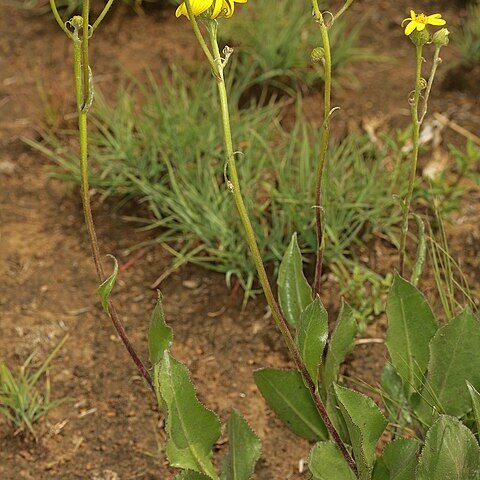Perennial herb up to c. 75 cm tall, rootstock silky-woolly, old fibrous leaf bases often present as well, roots woolly, flowering stems one or several from the crown, simple below the inflorescence, loosely woolly, glabrescent, leafy in the lower part. Radical leaves very variable in size, (5-)10-40 cm long, about half of this petiolar, blade narrowly to broadly elliptic, 0.5-8 cm wide, apex acute to obtuse', narrowed to a broad petiole-like base, expanded below, half-clasping and there persistently silky-woolly, margins minutely callose-denticulate, both surfaces lightly cobwebby, usually glabrescent, cauline leaves similar but sessile, soon distant and passing into lanceolate-acuminate bracts. Heads radiate, 2-20 corymbosely arranged. Involucre campanulate, bracts (16-)20, (7-)8-10 mm long, thinly woolly to glabrdus, calyculus bracts few, short. Rays (8-)10-13, long and spreading, they and the disc bright yellow. Achenes 4 mm long, cylindric, ribbed, hairy.
Perennial herb; flowering stems up to 0.75 m high, 1 or several from crown, simple below inflorescences, loosely woolly, glabrescent, leafy in lower part; crown clothed in long silky-woolly hairs and old leaf bases. Leaves: blade of basal leaves narrowly to broadly elliptic or round, up to 200 x 80 mm, apex acute to obtuse, narrowed to petiole-like base, expanded below, half-clasping and silky-woolly there; stem leaves similar but sessile, concentrated in lower half, passing into bracts; both surfaces lightly cobwebby, glabrescent, leaf margins minutely callose-denticulate. Heads radiate, 2-20 corymbosely arranged. Involucral bracts (16-)20, (7-)8-10 mm long, thinly woolly to glabrous; calyculus bracts few, short. Flowers: ray florets (8-)10-13; ray and disc florets bright yellow; Oct.-Dec. Fruit with cypsela (and ovary) cylindric, ribbed, hairy.
Perennial herb, rootstock silky woolly. Flowering stems 1-several, up to 0.8 m high, simple, loosely woolly, glabrescent, leafy below. Leaves: radical leaves very variable, narrowly to broadly elliptic, 50-400 mm long, lower half petiole-like, ± clasping, silky-woolly, margins minutely callose-denticulate, both sides ± cobwebby, glabrescent; cauline leaves similar but sessile, becoming bracts. Inflorescence a 2-20-headed corymb. Capitula radiate, disc and rays bright yellow, rays 8-13, long, spreading; involucre campanulate; bracts 16-20, 7-10 mm long; calyculus bracts few, short. Flowering time mainly Aug.-Nov. Cypselae cylindrical, 4 mm long, ribbed, hairy.
Tufted, thinly cobwebby perennial with woolly crown, to 40 cm. Leaves mostly basal, petiolate, obovate, leathery, margins crenulate to finely dentate. Flower heads radiate, large, in lax corymbs on sparsely leafy scapes, yellow, involucre conspicuously calycled.
Perennial herb, up to 0.75 m high. Crown clothed in long silky-woolly hairs. Leaves lightly cobwebby, glabrescent, leaf margins minutely callose-denticulate. Involucral bracts (7-)8-10 mm long. Heads radiate. Achenes and ovaries hairy. Flowers bright yellow.
A herb.

